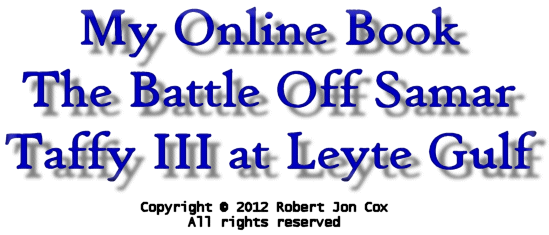
COMMENTS ARE ENABLED ON THE BOTTOM OF THE PAGE
Chapter 5
0035 to 0630
SAN BERNARDINO STRAIT
Wednesday, October 25, 1944
|
Time-Line, Events, & Comments
|
0035 On October 25, 1944, the Imperial Japanese Navy Centre Force, in single column, exited the restricted narrows of San Bernardino Strait unopposed and entered the Philippine Sea. All hands were alert and at their battle stations expecting the telltale flash of U.S. battleship guns.
| A/C The navigation of San Bernardino Strait by a large number of warships was said to be impossible by some, if not extremely hazardous. The successful piloting of the strait can be attributed to the excellent seamanship of the Japanese sailor.
|
VADM Matome Ugaki, IJN Commander Battleship Division ONE HIJMS YAMATO
|
The U.S. fleets were under strict orders not to enter the strait for fear of Japanese mines. In fact, all internal waterways in the Philippines islands were suspected to be heavily mined.
A/C Vice Admiral Kurita rightfully thought he would have to fight is way out of San Bernardino Strait. Fearing the Americans would "cross the ‘T’" of his force as they transited the narrow strait, his ships may well have fallen easy prey to the radar controlled 16-inch guns of Third Fleet’s fast battleships. The Americans would clearly hold the advantage. If caught in this predicament, he would be unable to maneuver in the restricted waters of the strait and would have only the forward guns on his ships able to respond. The American battleline, steaming in formation across the end of the strait, would be in position to bear all their guns on the approaching fleet as it exited the strait one-by-one. All the Japanese ships would be subjected to concentrated fire as they approached the base of the American "T."
A/C When it became apparent that the American fast battleships were not there to meet him, the next logical consideration under the circumstances was a submarine attack. To the admiral’s relief, there were no torpedo wakes either. Shortly after the last ship exited San Bernardino Strait, they prepared to form a standard night-search disposition.
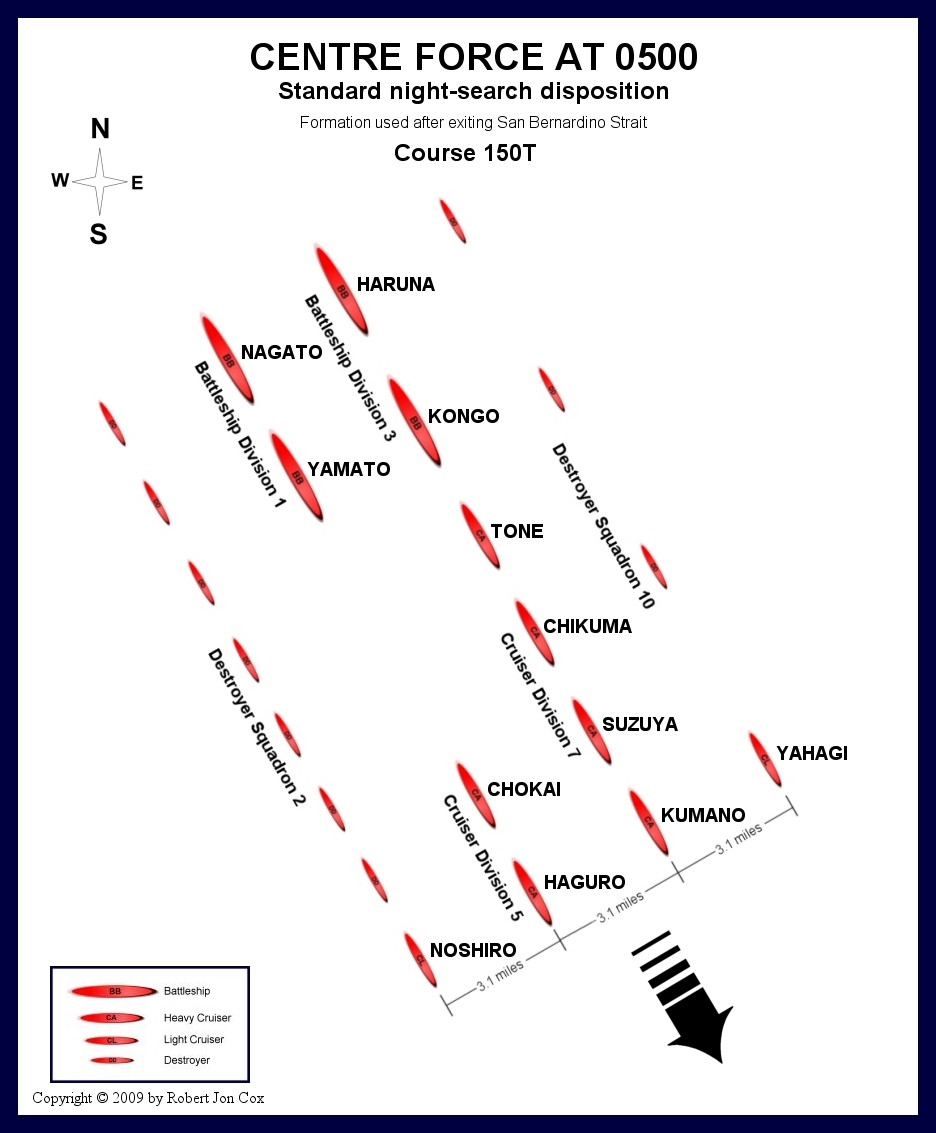
EVENT Upon exiting the other side of San Bernardino Strait and entering the Philippine Sea, Centre Force is ordered to head east for open ocean. They form four columns, each 3.1 miles apart, on a broad 9.3 mile front, forming a standard night-search disposition.
A/C Vice Admiral Kurita still expected the Americans to resist their sortie at any moment. As Centre Force sailed along cautiously, the admiral made plans for the morning which he knew would once again bring out the American carrier borne air strikes.
EVENT The Van and Rear of the Japanese Southern Forces are contacted via ship-to-ship radio by VADM Kurita and are ordered " . . . all forces will meet at 1000 off the southern tip of Samar...."
A/C This comment sounded quite casual considering what had happened to Centre Force the previous day in the Sibuyan Sea. Third Fleet carriers would have his force in range during their entire sortie; daylight air attacks were only a matter of time. Vice Admiral Kurita was set upon making the best of his current situation and he planned accordingly.
| EVENT Task Unit 77.4.3, commanded by RADM C.A.F. "Ziggy" Sprague is in its assigned night operations area off the island of Samar. It is one of the three "Taffies" providing close air support for the Leyte Gulf amphibious landing. Taffy III consists of six escort carriers, or CVEs, covered by a small screen of three destroyers and four destroyer escorts.
A/C CVEs were known throughout the fleet as Combustible, Vulnerable, and Expendable, or "Kaiser coffins", named after their manufacturer, Henry J. Kaiser. Taffy III's CVEs were CASABLANCA Class escort carriers; 512 feet long, 108 feet of beam, displacing 7,800 tons. Their armament consisted of a single 5-inch gun on their fantail, eight twin 40mm and twenty 20mm anti-aircraft guns. Their biggest asset was their thirty aircraft. On average they carried 12 General Motors TBM Avenger torpedo bombers and 18 General Motors FM-2 Wildcat fighters. |
TASK UNIT 77.4.3 (Taffy III) RADM Clifton A.F. Sprague
Destroyers Destroyer Escorts |
A/C Taffy III had three FLETCHER Class destroyers in its screen. Each destroyer had five 5-inch radar controlled guns and two 5-mount torpedo tubes. The four smaller destroyer escorts had two 5-inch guns apiece without radar control and only three torpedo tubes. The destroyers were ten knots faster than the destroyer escorts and they required 100 more men.
EVENT Inside the Combat Information Center aboard Taffy III screening ship DE SAMUEL B. ROBERTS all appears to be routine. Lieutenant Commander Robert W. Copeland, her commanding officer, and LT Everett E. Roberts, Jr., her executive officer, listen to the radio reports of the action in Surigao Strait with great interest.
A/C Both men had stayed up all night listening to the radio reports concerning the action in Surigao Strait. They probably felt at this time that this was the closest they would ever come in actual combat with an enemy surface fleet. ROBERTS was one of the smallest ships of the fleet, outfitted primarily for anti-submarine duty.
| A/C The thirteen ships of Taffy III were currently in their night operating area, further out to sea than during the day when they would be conducting air operations.
|
CTU 77.4.3/COMCARDIV 25 Action Report RADM Clifton A.F. Sprague, USN
|
Destroyer MICHISHIO leads, followed in a single line by DD ASAGUMO, BB YAMASHIRO, and BB FUSŌ. The heavy cruiser MOGAMI brings up the rear. Two destroyers patrol the port and starboard flanks, DD SHIGURE and DD YAMAGUMO respectively.
A/C After being harassed continuously by torpedo boats, VADM Nishimura decided it was time to form his ships into their battle order. This was the formation they would use to enter Surigao Strait and battle their way into Leyte Gulf. He presently knew nothing of the American force awaiting him at the north end of the strait, nor was he coordinating his attack by waiting for VADM Shima’s Rear forces to catch up with those of his own.
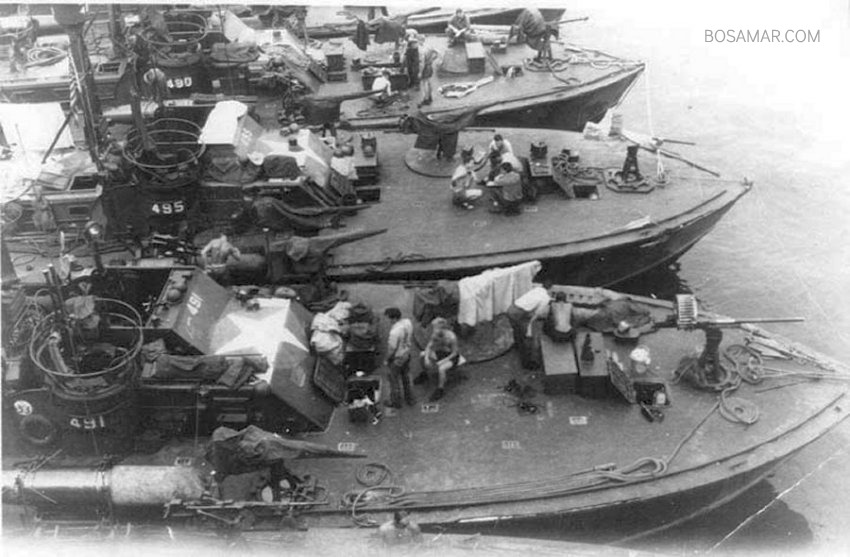
National Archives Photograph
Three U.S. Motor Torpedo Boats, PT-491, PT-495, and PT-490
Participants of the Battle of Surigao Strait
|
A/C One interesting fact is that while the Southern Force Van proceeded toward Surigao Strait, encountering torpedo boats along the way, after each encounter the Van would radio VADM Kurita and VADM Shima’s forces stating, "...destroying enemy torpedo boats...." Vice Admiral Nishimura communicated his actions to the Rear, yet he was unwilling, so it seemed, to join forces with them. 0155 Vice Admiral Kinkaid, Commander Seventh Fleet, orders RADM Thomas Sprague, Commander Task Group 77.4 to direct his escort carrier commanders to fly three dawn searches, one of which is to cover San Bernardino Strait and its eastern and western approaches. This is done mostly to satisfy VADM Kinkaid’s curiosity. He feels quite comfortable knowing (self-convinced) VADM Lee's Task Force 34 fast battleships are guarding San Bernardino Strait. |
VADM Thomas Kinkaid, USN Commander Seventh Fleet
|
The paraphrased CTF 77 dispatch read:
Action: CTF 77.4
Info: CTF 77, 78, 79, Com 3rd Flt, CTF 38, Com FEAF
SECRET
Carry out daybreak searches for Jap surface ships as follows: 340° to 030° distance 135. This serach originating Suluan Island. Make serach Mindanao Sea area distance 100 miles from Surigao Straits and Camote Sea area. Above 2 areas to be cleared by 0900 I. Our PTs operating in these areas. Keep 24 VT strike group with 12 torpedoes loaded at set to launch with VF escort in case of surface contact. Attack and Search groups keep in touch with Halifax 4915.
0208 Vice Admiral Mitscher's Task Group 38 reconnaissance aircraft sight battleships ISE and HYUGA, accompanied by four destroyers.
| 0230 Vice Admiral Kinkaid’s destroyer forces in Surigao Strait are deployed and ready for action.
A/C His force was in fact under attack from torpedo boats since just shortly before midnight. Thirty-nine torpedo boats were split into thirteen 3-ship groups. Their mission was to report Japanese ship movements, maintain contact and, if possible, to attack. A/C Well ahead of schedule and at his present rate of advance, VADM Nishimura's Southern Force Van would penetrate Surigao Strait and arrive in Leyte Gulf about six hours ahead of Centre Force, upsetting the GHQ plan to attack simultaneously. A/C It should have been very apparent to VADM Kurita that his two Southern Force Commanders were not coordinating their attack. The Southern Force Rear was currently about 40 miles behind the Van and was making no effort to catch up. The two admirals were simply unwilling to coordinate their forces to storm through Surigao Strait together. Unbelievably, no action was taken by VADM Kurita, nor GHQ in Tokyo, to remedy this situation. 0238 Vice Admiral Ozawa's carriers and escorts are sighted by Task Force 38 reconnaissance aircraft. Believing they are within 90 miles of his Task Force, VADM Mitscher recommends the formation of Task Force 34. Admiral Halsey approves the recommendation to form Task Force 34. A/C The Japanese carriers were actually 210 miles from the Americans. Task Force 34 was then formed and consisted of battleships WASHINGTON (flagship of VADM Lee), ALABAMA, IOWA, NEW JERSEY (flagship of ADM Halsey), MASSACHUSETTS, and SOUTH DAKOTA, heavy cruisers WICHITA and NEW ORLEANS, light cruisers VINCENNES, MIAMI, BILOXI, SANTA FE, and MOBILE, and eighteen destroyers. |
DESTROYER FORCES in Surigao Strait
DESRON "X" CDR Marshall S. Hubbard, USN DESRON 56 CDR Roland N. Smooth, USN DESRON 24 CAPT Kenmore M. McManes, USN |
0255 The communication center aboard Taffy II flagship CVD NATOMA BAY intercepts a voice transmission indicating that light and heavy surface units of CTF 77 are engaging Japanese forces attempting to transverse Surigao Strait and enter Leyte Gulf.
0300 Well into open ocean, Centre Force now turns southeast, steaming at 20 knots off the east coast of Samar.
0309 Approaching Surigao Strait in battle order, BB FUSŌ comes under attack by American destroyers and is hit by at least one torpedo. Numerous fires erupt and her engine room is severely damaged. The fires spread to her magazines and a tremendous explosion blows the ship into two pieces.
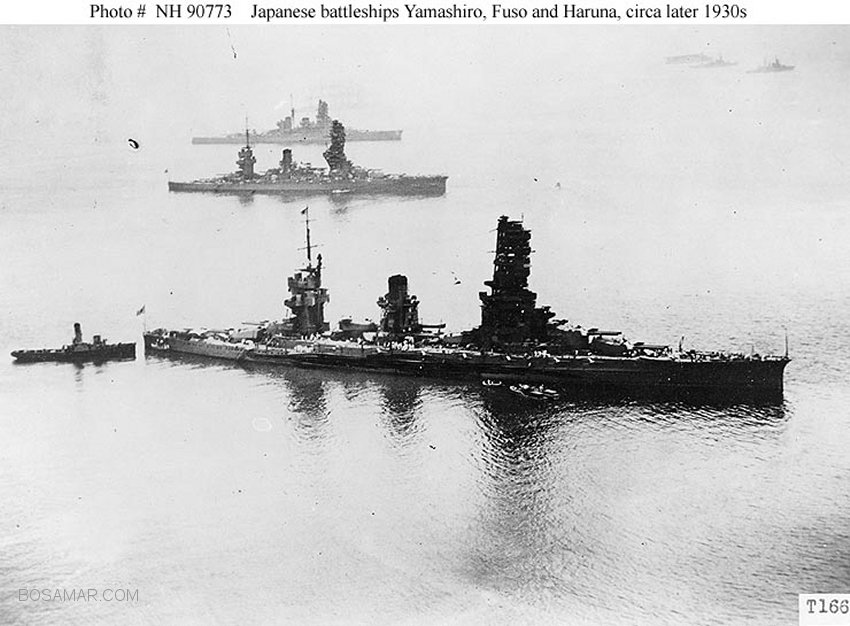
National Archives Photograph
Imperial Japanese Navy battleships YAMASHIRO, FUSŌ, and HARUNA
0320 Light cruiser ABUKUMA of the Southern Force Rear is struck by a torpedo from PT 137, killing 30 men. Unable to continue north, she is detached from the Rear by VADM Shima and is sent westward to retire at 9 knots.
0320 Destroyer MONSSEN hits BB YAMASHIRO with one torpedo. Badly damaged, two magazines are immediately flooded to avoid a possible catastrophic explosion.
0320 In what is considered the most successful American destroyer torpedo attack of the entire war, the destroyer McDERMUT cripples the Van’s destroyers MICHISHIO and ASAGUMO, and sinks DD YAMAGUMO outright, which explodes so violently it is seen 20 miles away by RADM Oldendorf in CA LOUISVILLE.
A/C This was the beginning of the highly effective American destroyer attacks in Surigao Strait. The American destroyers approached in groups of three, launched their torpedoes, and retired at high speed back up the strait. At this time several destroyers came under intense fire but none were hit. During this phase of the battle, several Japanese ships were crippled or sunk. Battleships YAMASHIRO and FUSŌ are both seriously damaged by the attacks.
0330 In accordance with directions from CTF 77, Rear Admiral Thomas Sprague, Commander Task Group 77.4, orders Taffy II to provide aircraft for dawn searches in Surigao Straits and the Mindanao Sea from sunrise until 0900, through a sector from 340° T to 030° T for 135 miles from Suluan Island as a point of origin. At the same time the escort carriers of TG 77.4 are directed to keep strike groups in condition 11, loaded with torpedoes and SAP bombs. The message is received an hour late by RADM Stump on CVE KADASHAN BAY and he later tasks CVE OMMANEY BAY with the mission. Ten Avengers are prepared for this mission on a rain-soaked deck but the planes are not ready to fly until almost 0700.
A/C The Philippine tropical weather, notably the rainy season, was taking its toll on air operations.
A/C In addition to their reconnaissance duties, the escort carriers were also notified to standby to attack the Japanese stragglers from the Battle of Surigao Strait. Because of this order, many of the CVEs were prepared to launch aircraft with torpedoes and semi-armor piercing bombs to deal with the stragglers of the Battle of Surigao Strait. Unknown by the CVE commanders, this planning would pay off ten-fold later in the morning during the Battle Off Samar.
0335 Vice Admiral Kurita receives another message from VADM Nishimura’s Van stating his force has sighted three enemy ships.
A/C The worst was yet to come for the Van. Rear Admiral Jesse Oldendorf had assembled a large reception for the Japanese forces approaching Leyte Gulf from the south. On station northwest of Hibuson island at the northern entrance to Surigao Strait were all six old battleships, four heavy cruisers, and four light cruisers.
0351 The right and left flank cruisers open fire with their main batteries on the approaching Van.
A/C Battleship YAMASHIRO was about eleven and one-half miles from the Seventh Fleet battleline when the order to open fire was given. The heavy cruisers were stationed about three and one-half miles south of the battleships, closer to the approaching Japanese. Vice Admiral Nishimura’s remaining forces were met with a torrential downfall of 16, 14, 8, and 6-inch shells.
0353 Battleship WEST VIRGINIA opens fire with her 16-inch main batteries on the Van.
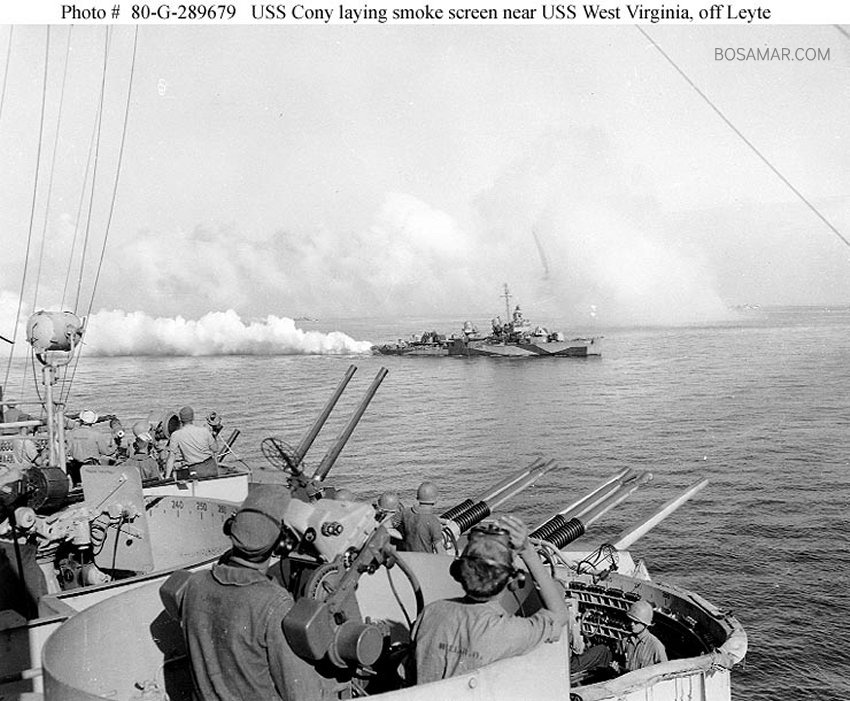
National Archives Photograph
Seen from old battleship USS WEST VIRGINIA (BB-48), FLETCHER Class destroyer
USS CONY (DD-508) lays a smoke screen off Leyte during the invasion
| 0355 Battleships CALIFORNIA and TENNESSEE open fire with their 14-inch main batteries on the Van.
0359 Battleship MARYLAND opens fire with her 16-inch main batteries on the Van. A/C Only DD SHIGUREsurvived the onslaught of RADM Oldendorf’s battleline. They defended the strait brilliantly by crossing the enemy's "T", a tactic which had become the envy of battleline commanders since the day of the Japanese-Russo one-sided duel in Tsushima Strait in May 1905. Oldendorf’s battleline was deployed across the northern end of Surigao Straight with all guns bearing southward on the approaching Japanese warships. When the Van initially approached, torpedo boats first attacked, followed by the destroyers. Rear Admiral Oldendorf's six old battleships, cruisers, and assorted vessels made quick work of the Southern Force Van. Battleships YAMASHIRO and FUSŌ were sunk outright, as were most of the other unfortunate ships. 0400 Centre Force changes course to 150° and steams nearly southward, 10 miles off Samar. |
SEVENTH FLEET BATTLELINE DURING THE BATTLE OF SURIGAO STRAIT Commander Bombardment and Support Group RADM Jesse B. Oldendorf, USN
Right Flank Cruisers RADM Russell S. Berkey, USN Left Flank Cruisers RADM Jesse B. Oldendorf, USN |
| RADM Oldendorf’s battleline crosses the "T" and destroys the Southern Force Van |
EVENT Vice Admiral Shima’s Southern Force Rear warships proceed northward up the approach to Surigao Strait at 28 knots. His four destroyers lead, followed by heavy cruisers NACHI and ASHIGARA.
EVENT Vice Admiral Shima shortly thereafter sights what appears to be two burning ships in the water ahead. He immediately concludes they are the Van’s two battleships FUSŌ and YAMASHIRO. Next he sights the Van's retreating destroyer SHIGURE, which is having rudder difficulties. Heavy cruiser NACHI and DD SHIGURE exchange recognition communications and SHIGURE continues southward.
A/C The two burning ships VADM Shima sighted were in fact the two separate halves of BB FUSŌ. After DD SHIGURE encountered VADM Shima’s Rear, the retreating destroyer proceeded southward without giving any information to the advancing Rear about the demise of the Van. This was another clear indication of the lack of coordination and communications which plagued the entire southern pincher operation.
| EVENT The Van’s CA MOGAMIis sighted "dead in the water" by the advancing Rear forces. Although she has been hard hit, MOGAMI is still making way, unknown by VADM Shima's advancing Rear forces.
A/C Battleship MISSISSIPPI had great difficulty locating a target for her guns; she finally ranged off of the other ship's shell fall. |
CDR Kokichi Mori, IJN Staff Officer HIJMS NACHI - Southern Force Rear
|
A/C The order to cease fire was given by RADM Oldendorf because the American destroyer ALBERT W. GRANT of CDR Smoot’s DESRON 56 was repeatedly hit by friendly shell fire from 0407 onward. This was to be the only significant damage suffered by the Americans during the Battle of Surigao Strait, except for a few unlucky PT boats which received only minor damage.
|
A/C Although the amount of ordnance placed on the Southern Force Van was great, of the six old battleships present, only four fired more than one salvo. Battleship WEST VIRGINIA led with 93 rounds of 16-inch armor-piercing shells. TENNESSEE came in second with 69 14-inch shells, and CALIFORNIA managed 63. MARYLAND's 16-inch guns fired 48. Due to their antiquated fire-control radar, MISSISSIPPI fired only one salvo and PENNSYLVANIA none at all. Because of their lack of armor-piercing ammunition, the battle plan required the battleships to withhold their fire until the Japanese had approached to within 20,000 yards. |
BATTLE LINE gun size and shell expenditures in Surigao Strait action |
||
| Batteship | Gun Size |
Shells Expended |
|
| WEST VIRGINIA | 16 | 93 | |
| TENNESSEE | 14 | 69 | |
| CALIFORNIA | 14 | 63 | |
| MARYLAND | 16 | 48 | |
| MISSISSIPPI | 14 | 9 | |
| PENNSYLVANIA | 14 | 0 | |
A/C The cruisers on the other hand, fired their main batteries in rapid fire mode. Rear Admiral Oldendorf’s left flank cruiser COLUMBIA fired 1,000 rounds alone. This number is astounding when you consider the total number of shells fired by the cruisers was 3,100. Two ships of this group, PHOENIX and BOISE, fire their main batteries in continuous rapid fire and later slowed to conserve ammunition.
| 0412 Vice Admiral Kinkaid and his staff meet during the Battle of Surigao Strait and review Seventh Fleet tasking for the day’s upcoming events. The battle in Surigao Strait is coming off like clock- work. Vice Admiral Kinkaid and his staff are extremely pleased with RADM Oldendorf's success.
EVENT Seventh Fleet sends ADM Halsey the following message inquiry: "...QUESTION. IS TF 34 GUARDING SAN BERNARDINO STRAIT?" It wasn't. Subsequently, the message is not received by Admiral Halsey until 0648. |
VADM Thomas Kinkaid, USN Commander Seventh Fleet
In the middle of the night or early morning of the 25th I called a meeting in my cabin of the staff and everyone connected with operations to see if there was anything they had forgotten to do, or anything doing that was wrong, to see if anything needed change or to be added to. All went over the situation." |
0415 Aboard escort carrier GAMBIER BAY Flight Quarter Stations are manned.
0419 Vice Admiral Nishimura’s flagship BB YAMASHIRO, severely damaged by the battleline, is hit on her port side by two torpedoes from the DD NEWCOMB. Unable to sustain further damage, she finally sinks, taking with her VADM Nishimura.
0420 Southern Force Rear heavy cruisers NACHI and ASHIGARA prepare to launch a torpedo attack against two targets gained on their surface radar.
EVENT Shortly thereafter, VADM Shima’s heavy cruisers launch eight torpedoes apiece by radar. Heavy cruiser NACHI then literally runs into trouble. Unaware that the Van’s CA MOGAMI is making way, CA NACHI is struck on her port side by the Van's damaged heavy cruiser, causing serious damage to both ships. As a result, CA NACHI is forced to retire to assess her damage.
A/C The Southern Force Van’s piecemeal destruction was closely followed by the Rear’s retreat. Vice Admiral Shima, upon seeing the fate of VADM Nishimura's force, knew he was out-gunned and quickly chose not to go any further. This was the American high-water mark of the Battle of Leyte Gulf followed shortly thereafter by, farther to the north, the Battle Off Samar.
EVENT Aboard Taffy III's DE ROBERTS in her Combat Information Center, word is heard over the radio that the Japanese fleet has been routed in Surigao Strait. As a result, her Commanding Officer, LCDR Copeland, is lulled into a false sense of security.
0430 Taffy II is ordered by CTU 77.4 to comply with air search plan requested by Commander Support Air for CTF 77. This search is to locate, report and attack enemy ships escaping to the west of Surigao Straits.
|
0430 Ships in all three Taffies go to General Quarters for morning air operations. Planes assigned to Combat Air Patrol, anti-submarine patrol, and reconnaissance duties are readied and launched before sunrise. 0431 Destroyer Escort DENNIS assumes cruising formation within the task unit. A/C DENNIS was the senior destroyer escort within Taffy III, as determined by the seniority of her Commanding Officer, Lieutenant Commander Hansen. 0457 Escort carrier GAMBIER BAY commences launching 8 FM-2 Wildcat fighters. 0500 The first scheduled flights for Task Unit 77.4.3 are launched. 0505 The last FM-2 Wildcat fighter from CVE GAMBIER BAY’s morning Combat Air Patrol is launched. |
CTU 77.4.3/COMCARDIV 25 Action Report When the enemy attack by the southern force through Surigao Straits developed, the question of the whereabouts of the enemy northern component (Centre Force) became even larger and more formidable. This unit had never been assigned any responsibility for covering the exit of San Bernardino Straits, either by reconnaissance or by force, and in the absence of any information that this exit was no longer blocked, it was logical to assume that our northern flank could not be exposed without ample warning. Had this T.U. had any reason to suspect that an enemy sortie could be made through San Bernardino Straits undetected by other U.S. forces, a search to the northwest would have been launched from a more easterly position, and it is possible that a direct surface action could have been avoided. |
0522 The crew of DE DENNIS man their battlestations for dawn alert. Condition Easy is set.
0530 Escort Carrier ST LO launches a Target Anti Submarine Patrol of two Avenger Torpedo Bombers and four Wildcat FM-2 fighters for the Leyte Gulf area.
A/C Taffy III completed the launching of a Target Combat Air Patrol consisting of 12 fighters to protect the shipping in Leyte Gulf.
|
0530 Destroyer Escort RAYMOND mans battlestations (Condition I). EVENT As daylight proper soon approaches, Centre Force is directed to form a defensive circular formation to maximize their anti-aircraft protection from the air attacks, expected to arrive shortly. A/C This circular formation was their best proven defense from air attack. An air attack by Third Fleet aircraft was expected shortly after first light. As before in the Sibuyan Sea, the battleships and heavy cruisers would group in the center with the destroyers on the outside perimeter. |
TU 77.4.2/COMCARDIV 24 Action Report CTF 77 estimated a major surface engagement would take place the night of 24-25 October in SURIGAO STRAITS and requested TG 77.4 to be prepared to search for and launch a torpedo attack against enemy cripples at dawn. CTU 77.4.2 alerted the Task Unit for this eventuality. Although it was not known at the time, a Jap carrier force had approached from the north and TF 38 was enroute north to attack. During the night a surface force of heavy Jap ships attempted to enter LEYTE GULF via SURIGAO STRAITS and were successfully engaged and in the majority sunk. |
0532 Admiral Kurita receives a message from RADM Shima, Southern Force Rear Commander, stating that VADM Nishimura’s Southern Force Van "has been destroyed."
0532 Destroyer Escort JOHN C. BUTLER mans battlestations for regular morning alert.
0545 Rear Admiral Thomas Sprague's Task Unit 77.4.1 (Taffy I) launches aircraft to pursue the fleeing remnant of the Japanese Southern Forces in Surigao Strait. The strike consists of 11 Avenger TBM-1C torpedo bombers loaded with torpedoes and 17 Wildcat FM-2 fighters loaded with 500 pound SAP bombs.
0545 Air operations complete, DE DENNIS changes course to 350° T, speed 15 knots, and assumes cruising disposition 5-R within the task unit.
0551 Ensign Hans L. Jensen is launched from Taffy II's CVE KADASHAN BAY in his TBM-1C for an anti-submarine patrol mission in the waters off Samar.
0600 Escort carrier GAMBIER BAY and the other ships of Taffy III steam northward off the coast of Samar in their assigned operations area, unaware of the impending danger from the Japanese Centre Force.
0600 Destroyer Escort DENNIS commences zig-zagging according to plan #25 of USF 10A.
0607 A Support Group of four torpedo bombers is launched from the escort carriers of Taffy III. Shortly thereafter, two more are launched as Target Anti-Submarine Patrol sweep in the same area. Aircraft to safeguard Taffy III are also launched.
|
A/C The new day's sun rose slowly with partly overcast skies and occasional rain squalls, typical for this time of year. 0620 Escort Carrier ST LO secures from General Quarters. The weather is spotty, with scattered, fairly extensive, rain squalls and considerable haziness. 0623 U.S. aircraft are detected by radar from BB YAMATO. 0624 Sunrise. Wind from 035° T with force of 3-5 knots, sea comparitively calm with slight swell. Visibility poor and varied from 4-7 miles. 0630 Aboard Taffy III flagship CVE FANSHAW BAY, RADM Clifton Sprague sends a signal by TBS directing all ships of Taffy III to "...secure from General Quarters. Set Condition 3," normal underway watches. |
CAPT Walter V.R. Vieweg, USN Commanding Officer USS GAMBIER BAY (CVE 73)
|
A/C The men of Taffy III considered the "busy work" for the morning over. The first aircraft of the new day were launched without incident. The men of Task Unit 77.4.3 would now enjoy breakfast, relax a while, and prepare for another busy day of providing air support for the invasion troops landed on Leyte.
Continue to TBS & Shackle Code or INDEX